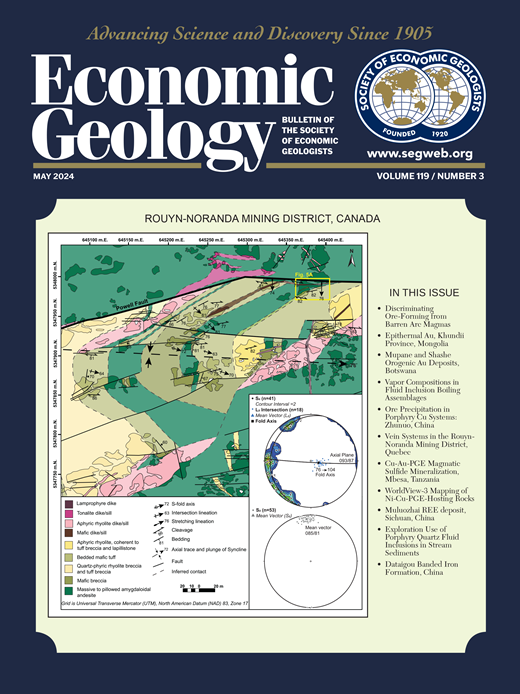Geochemical Signatures of Felsic Volcanic Rocks in Modern Oceanic Settings and Implications for Archean Greenstone Belts
IF 5.5
1区 地球科学
Q1 GEOCHEMISTRY & GEOPHYSICS
引用次数: 2
Abstract
Felsic volcanic rocks are abundant in ancient greenstone belts and important host rocks for volcanogenic massive sulfide (VMS) deposits. About half of all VMS deposits are hosted by dacite or rhyolite, an association that reflects anomalous heat flow during rifting, partial melting of basaltic crust, and fractional crystallization in high-level magma chambers. For over 30 years, geochemical signatures of these rocks (e.g., F classification of Archean rhyolites) have been widely used to identify possible hosts for VMS deposits in ancient greenstone belts. However, comparisons with modern oceanic settings have been limited, owing to a lack of samples of felsic volcanic rocks from the sea floor. This is changing with increasing exploration of the oceans. In this study, we have compiled high-quality geochemical analyses of more than 2,200 unique samples of submarine felsic volcanic rocks (>60 wt % SiO2) from a wide range of settings, including mid-ocean ridges, ridge-hot-spot intersections, intraoceanic arc and back-arc spreading centers, and ocean islands. The compiled data show significant geochemical diversity spanning the full range of compositions of rhyolites found in ancient greenstone belts. This diversity is interpreted to reflect variations in crustal thickness, the presence or absence of slab-derived fluids (dry melting versus wet melting), and mantle anomalies. Highly variable melting conditions are thought to be related to short-lived microplate domains, such as those caused by diffuse spreading and multiple overlapping spreading centers. Systematic differences in the compositions of felsic volcanic rocks in the modern oceanic settings are revealed by a combination of principal components analysis, unsupervised hierarchical clustering, and supervised random forest classification of the compiled data. Dacites and rhyolites from midocean ridge settings have moderately depleted mantle signatures, whereas rocks from ridge-hot-spot intersections and ocean islands reflect enriched mantle sources. Felsic volcanic rocks from arc-back-arc systems have strongly depleted mantle signatures and well-known subduction-related chemistry (strong large ion lithophile element enrichment in combination with strong negative Nb-Ta anomalies and low heavy rare earth elements [HREEs]). This contrasts with felsic volcanic rocks in Archean greenstone belts, which show high field strength element and HREE enrichment (so-called FIIIb-type) due to a less depleted mantle, a lack of wet melting, and variable crustal contamination. The differences between modern and ancient volcanic rocks are interpreted to reflect the lower mantle temperatures, thinner crust, and subduction-related processes in present-day settings. We suggest that the abundance of FIIIb-type felsic volcanic rocks in Archean greenstone belts is related to buoyant microplate domains with thickened oceanic crust that were better preserved on emerging Archean cratons, whereas in post-Archean tectonic settings most of these rocks are subducted.现代海相长英质火山岩地球化学特征及其对太古宙绿岩带的指示意义
长英质火山岩在古绿岩带中富集,是火山成因块状硫化物矿床的重要寄主岩。大约一半的VMS矿床由英安岩或流纹岩组成,这种组合反映了裂谷过程中的异常热流、玄武岩地壳的部分熔融和高层岩浆房的部分结晶。30多年来,这些岩石的地球化学特征(如太古宙流纹岩的F分类)被广泛用于识别古绿岩带VMS矿床的可能寄主。然而,由于缺乏海底的长英质火山岩样本,与现代海洋环境的比较受到限制。随着对海洋探索的增加,这种情况正在改变。在这项研究中,我们对2200多个独特的海底长英质火山岩(>60 wt % SiO2)样本进行了高质量的地球化学分析,这些样本来自广泛的环境,包括洋中脊、脊-热点交叉点、洋内弧和弧后扩张中心以及海洋岛屿。整理的数据显示,古绿岩带流纹岩的地球化学多样性显著。这种多样性被解释为反映了地壳厚度的变化、板块衍生流体的存在与否(干熔融与湿熔融)以及地幔异常。高度可变的熔化条件被认为与短暂的微孔板域有关,例如由扩散扩散和多个重叠扩散中心引起的微孔板域。采用主成分分析、无监督分层聚类和监督随机森林分类相结合的方法,揭示了现代海洋环境中长英质火山岩组成的系统差异。来自洋中脊背景的英安岩和流纹岩具有中等贫地幔特征,而来自海中脊-热点交叉点和海洋岛屿的岩石则反映出富集的地幔源特征。弧-弧后体系的长英质火山岩具有强烈的贫地幔特征和众所周知的俯冲相关化学特征(强大离子亲石元素富集,结合强负Nb-Ta异常和低重稀土元素[hree])。这与太古宙绿岩带的长英质火山岩形成鲜明对比,由于地幔较少枯竭、缺乏湿融和地壳污染变化,长英质火山岩表现出高场强元素和高稀土元素富集(所谓的fiiib型)。现代和古代火山岩之间的差异被解释为反映了当今环境下较低的地幔温度、较薄的地壳和与俯冲有关的过程。我们认为太古宙绿岩带中fiiib型长英质火山岩的丰富与浮力微板块域有关,这些微板块域具有较厚的洋壳,在新兴的太古宙克拉通中得到了较好的保存,而在太古宙后的构造环境中,这些岩石大部分是俯冲的。
本文章由计算机程序翻译,如有差异,请以英文原文为准。
求助全文
约1分钟内获得全文
求助全文
来源期刊

Economic Geology
地学-地球化学与地球物理
CiteScore
10.00
自引率
6.90%
发文量
120
审稿时长
6 months
期刊介绍:
The journal, now published semi-quarterly, was first published in 1905 by the Economic Geology Publishing Company (PUBCO), a not-for-profit company established for the purpose of publishing a periodical devoted to economic geology. On the founding of SEG in 1920, a cooperative arrangement between PUBCO and SEG made the journal the official organ of the Society, and PUBCO agreed to carry the Society''s name on the front cover under the heading "Bulletin of the Society of Economic Geologists". PUBCO and SEG continued to operate as cooperating but separate entities until 2001, when the Board of Directors of PUBCO and the Council of SEG, by unanimous consent, approved a formal agreement of merger. The former activities of the PUBCO Board of Directors are now carried out by a Publications Board, a new self-governing unit within SEG.
 求助内容:
求助内容: 应助结果提醒方式:
应助结果提醒方式:


